How To Block Time in Google Calendar: Step-by-Step Guide
Table of Contents
Automatically block time in Google Calendar
Create an account in OneCal to automatically block time in all your Google Calendars.
Since remote work is the new norm, every meeting goes through our calendars first. Given that most professionals use Google Calendar to block time, it’s crucial to understand how to use this scheduling tool to block time and get more work done.
In this article, we’ll explain the ins and outs of Google Calendar Time Blocking, including techniques, challenges, and the best tools that help you be more productive.
What is Google Calendar Time Blocking?
Google Calendar Time Blocking is a time management technique that involves allocating specific blocks of time in your Google Calendar for certain tasks or activities. This approach is based on the principle of dedicating distinct periods to focused work, meetings, personal time, or any other activities, rather than approaching the day without a structured plan.
Worried about blocking time across multiple calendars? Read our detailed guide on How to Auto Block Time on Multiple Calendars.
How to block time in Google Calendar
To block time in Google Calendar, follow these steps:
1. Open Google Calendar
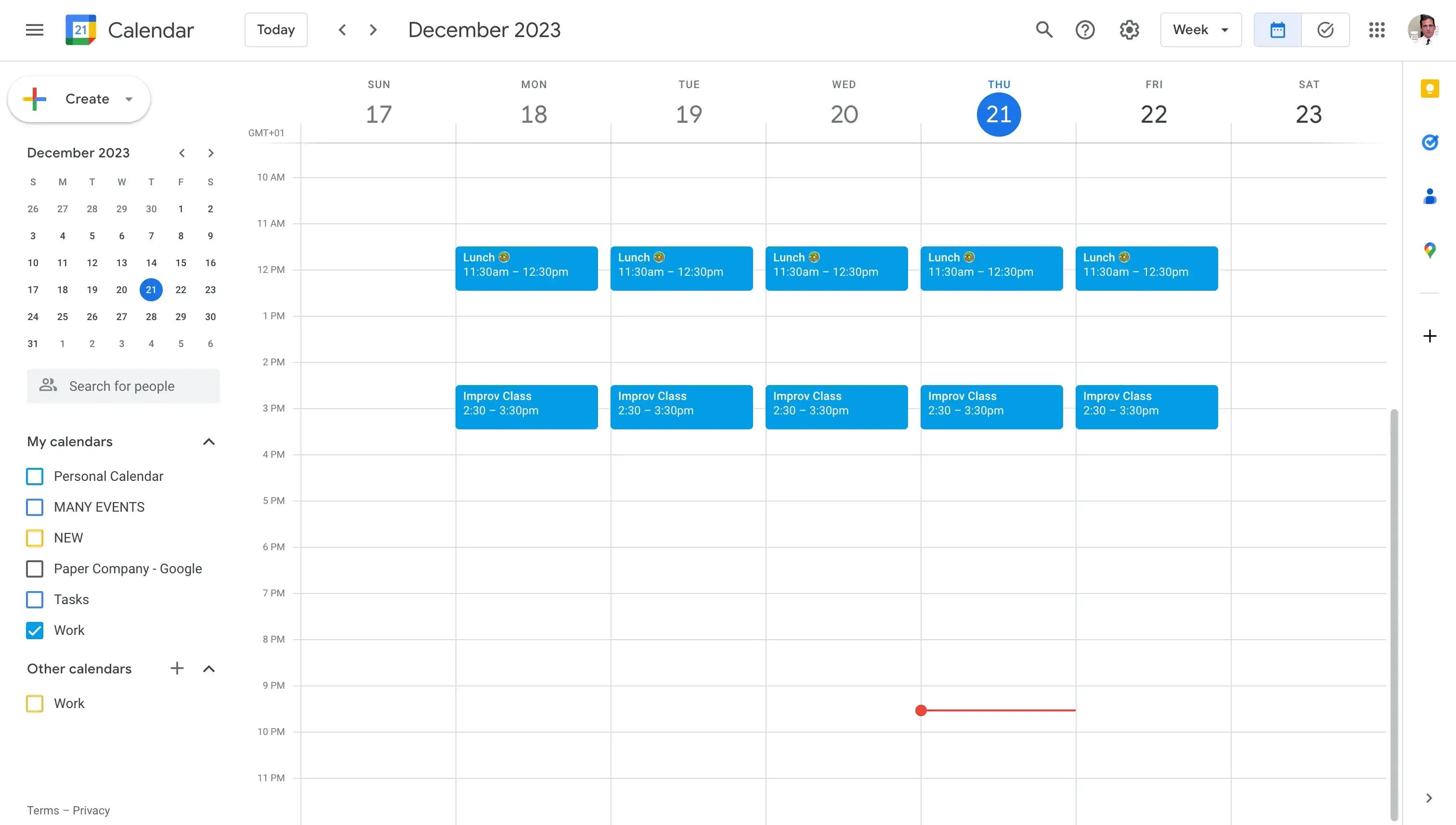
You can open Google Calendar on the web by following this URL: https://calendar.google.com/calendar/u/0/r
The same steps can also be followed on mobile
2. Select the calendar to block time to
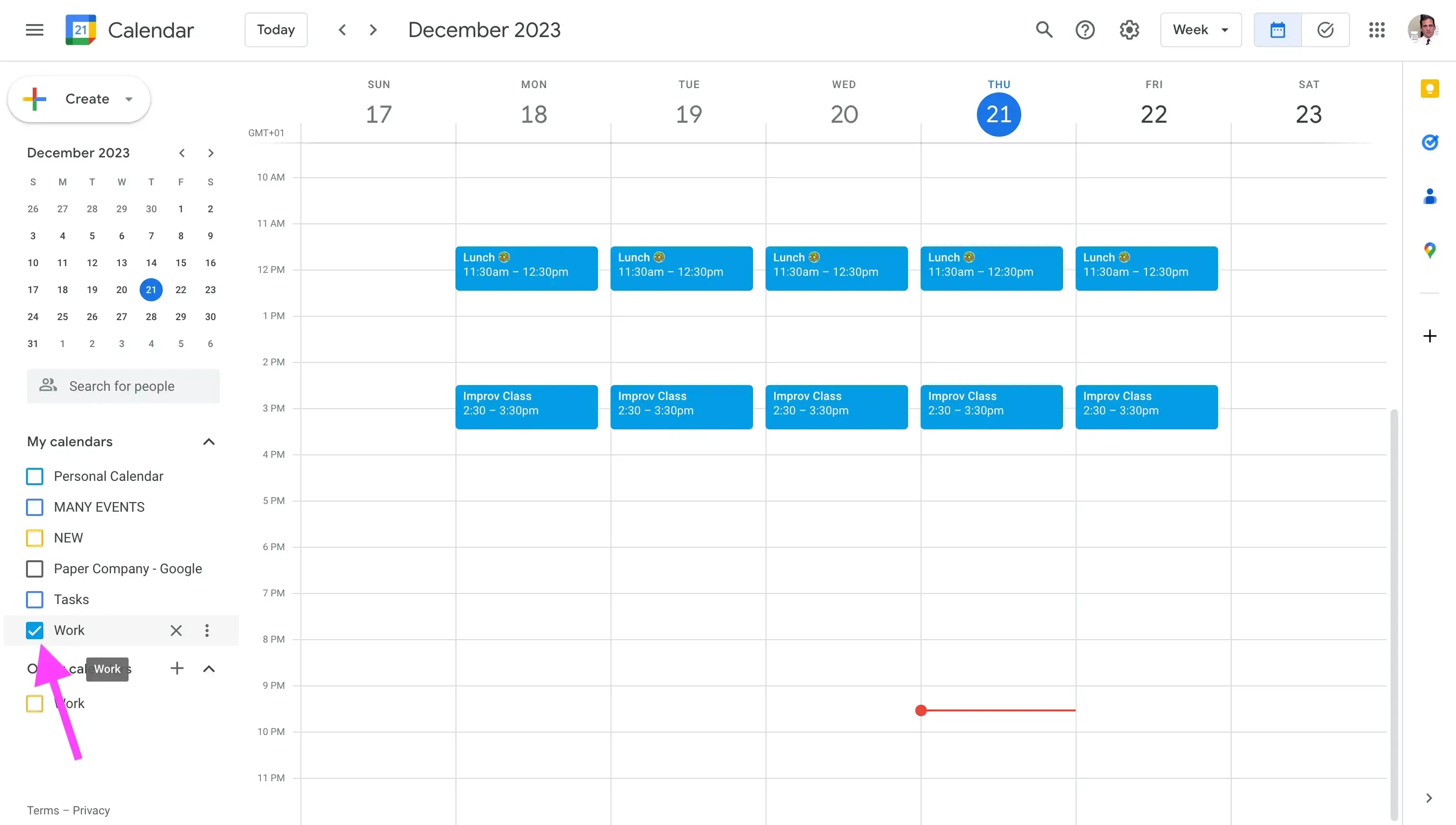
Make sure you’re blocking time in the right calendar, as you can have multiple Google Calendars under the same Google Calendar account.
3. Click under a block inside the calendar (or just click Create)
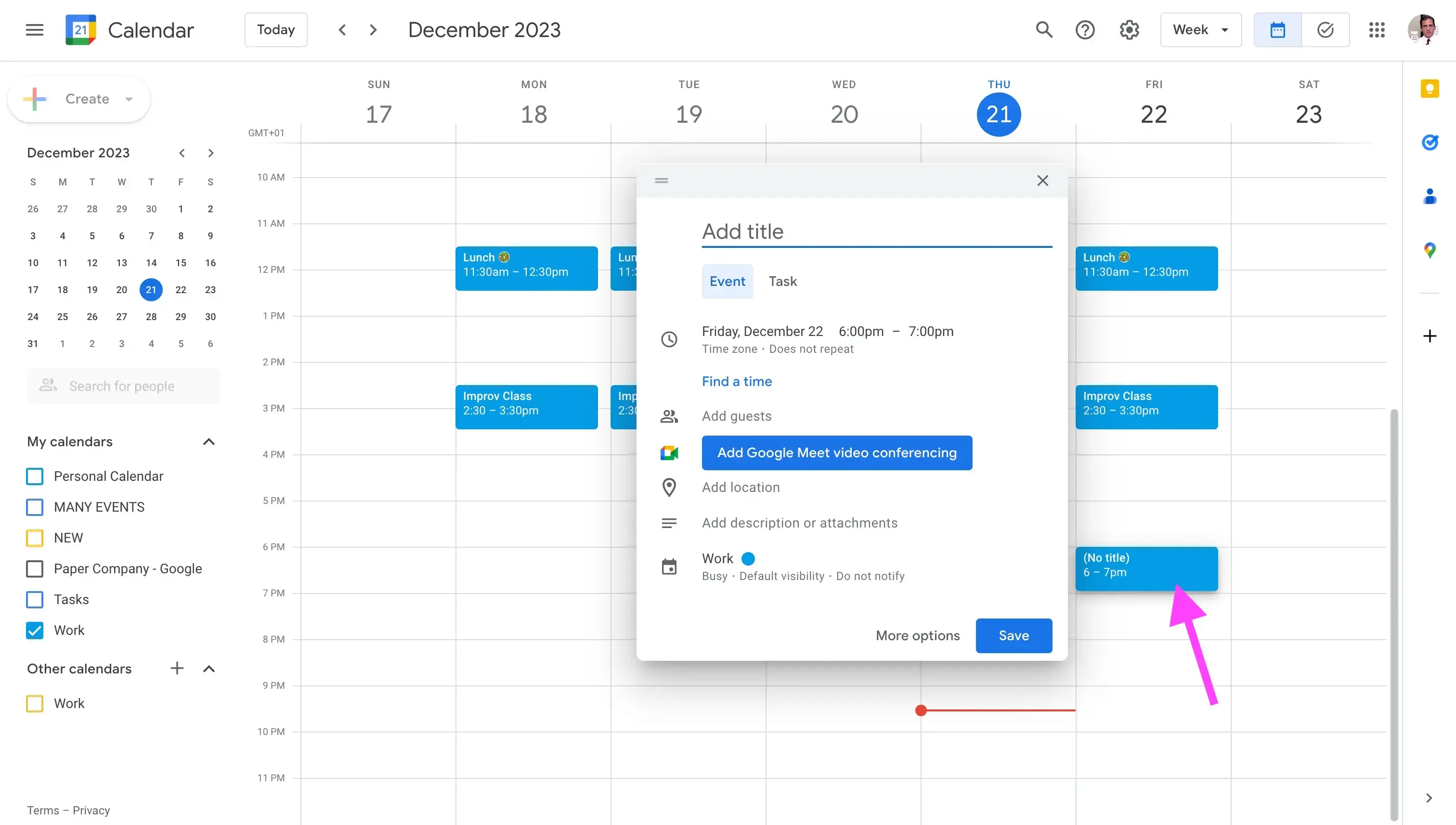
In Google Calendar, you can create a new meeting by clicking a slot on Google Calendar or clicking the Create button on the top left of the page.
4. Mark the event as Private
Marking the event as private makes it so only you can see the details of the event (title, description, etc), and others will only see a ‘Busy’ placeholder. This helps you to understand what have you blocked time for, and others understand that you’re busy at this time.
If you want co-workers to see the event details, you can mark the event as Public.
To mark the event as private, click More options on the event modal:
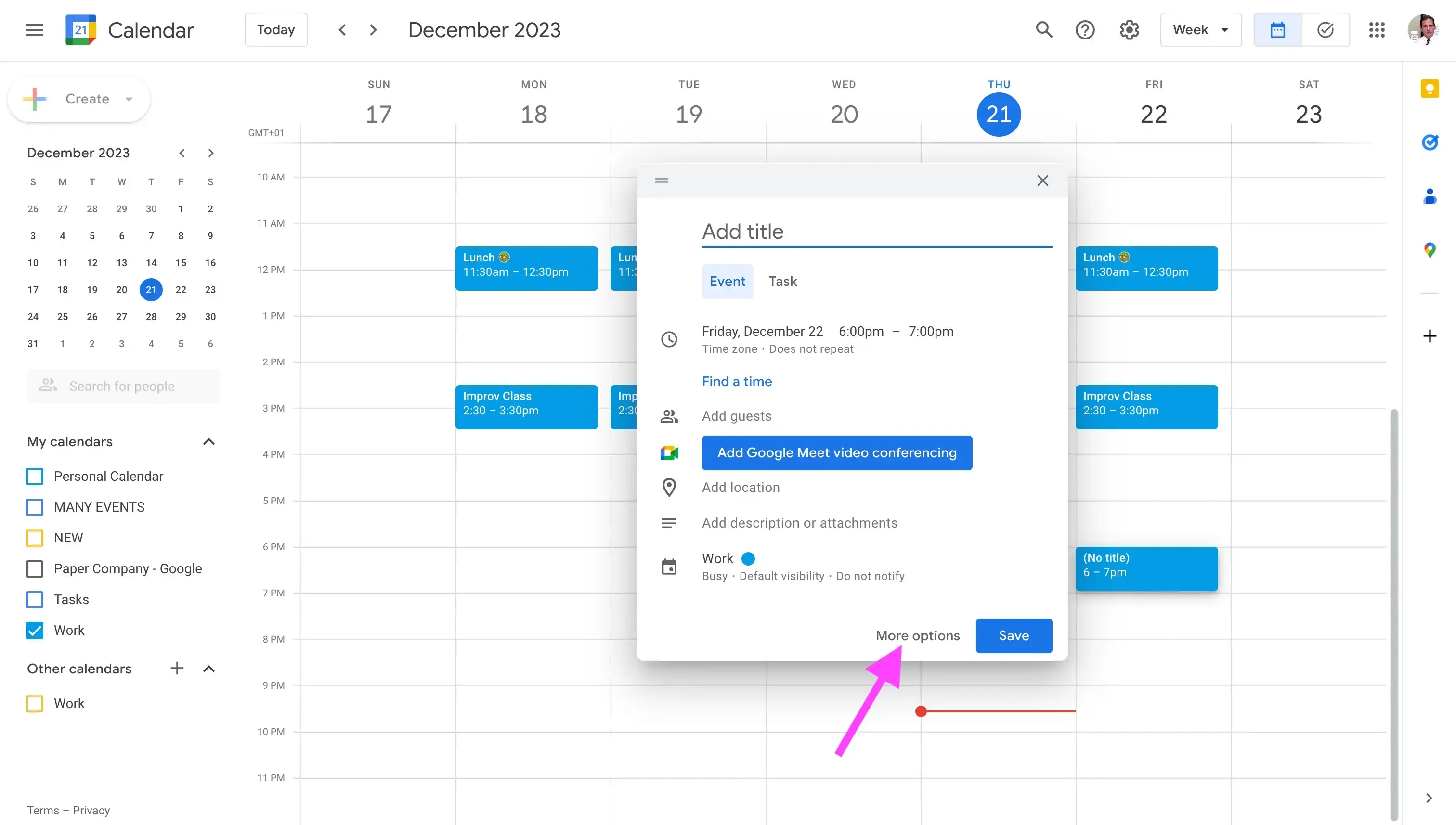
After clicking More options, select Private on the dropdown shown below:
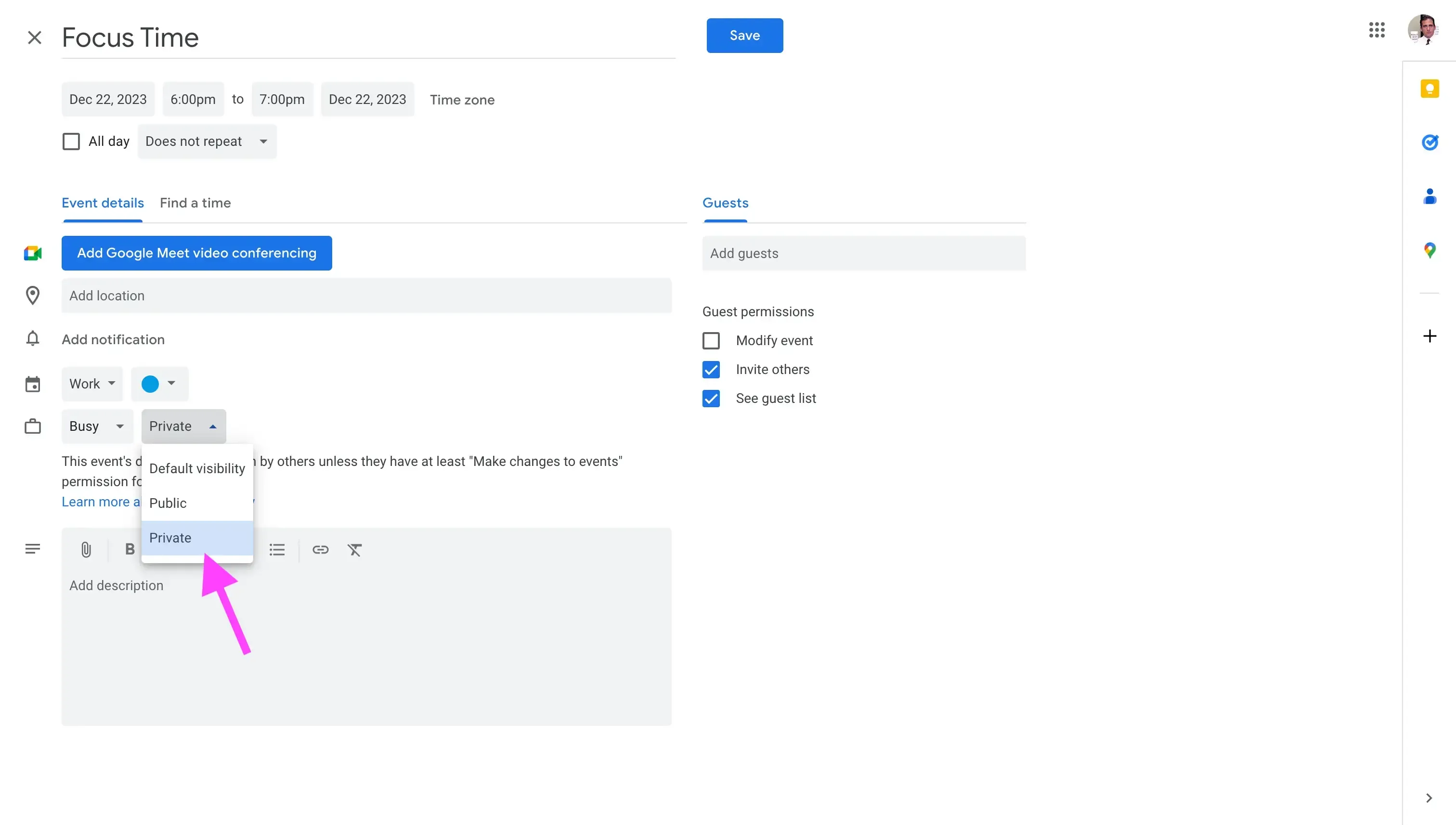
5. Set a title, duration, description, and other details

Setting a concise title and a clear description is important, as you won’t have to do mental gymnastics on why you’ve blocked time when seeing the calendar at a later point.
Why is Time Blocking Important?
Remote work has forced everyone to work from home and meet online. This means that most meetings happen digitally, using a web conferencing solution. It’s not uncommon to get invited to meetings while you’re working or you had already something else on your mind.
It’s also pretty normal for team members to notify one another of a meeting one hour (or less) before it starts. This can be a deal breaker if you’ve planned out your day, or if you’ve got more important work to do.
Here is what makes Google Calendar Time Blocking important:
1. Set clear Expectations with team members
Time Blocking helps you manage expectations with your team members, while also leaving time for them to book meetings with you. Keeping a balance between completing tasks and collaborating with colleagues is crucial in the workforce.
2. Streamlined schedule, planned day
It’s important to lay out the plans for a working day, leaving time for meetings, deep work, and preparations, while having a clear schedule and no surprises. This gives you a clear overview of what to accomplish during the day, and the slots to accomplish each task.
3. Makes you more productive
Time Blocking also helps you be more productive, as you won’t be interrupted by ‘urgent’ meetings now and then. When time blocking your Google Calendar, you know exactly what work needs to be done and when.
What are the challenges of Blocking Time in Google Calendar?
1. Difficult to block time on multiple Google Calendars
Blocking time in a single Google Calendar is easy, but things get complicated when more Google Calendars are involved. You can block time from one Google Calendar to another Google Calendar by sharing Google Calendars, but it comes at the expense of making the Google Calendar available to the public, exposing private meeting details. This is a huge deal if the meeting information is confidential, or contains private information.
Another issue is that Google Calendar updates (new meetings, or edits on existing meetings) don’t sync in real-time, increasing the chances of double-bookings.
Calendar Sync Tools like OneCal are designed to auto-block time on multiple Google Calendars without compromising on security or performance.
2. Takes time to adapt to blocking time for everything
For the time blocking to be effective, you have to block time for everything. Even though in theory it seems quite simple, it’s quite challenging to keep up with creating events for every single task or activity you have to do.
3. Inaccurate Time Estimates
One of the biggest challenges is accurately estimating how long tasks will take. People often underestimate the time required for a task, leading to overly optimistic schedules that are hard to follow.
4. Lack of flexibility
Strict time blocking can sometimes reduce flexibility. Unexpected tasks, emergencies, or extended meetings can throw off the entire schedule, causing stress and the need for constant readjustment.
5. Distractions and Interruptions
Despite having a well-planned schedule, external distractions (like phone calls, emails, or colleagues dropping by) and internal distractions (like procrastination or lack of focus) can disrupt time blocks.
How to block time across multiple Google or Outlook Calendars?
A lot of organizations work with more than one Outlook or Google Calendar, and it gets quite challenging to block time across all the calendars.
Manually Blocking time across multiple calendars by sharing
Although blocking time across multiple calendars by sharing is doable, it comes with some major drawbacks:
Slow Calendar Syncs: The bad news is that blocking across multiple calendars by sharing calendars means that the syncs are not real-time, and you have to wait 24 hours for calendars to be in sync.
No Privacy: To sync one calendar to another, you have to make the calendar public, meaning that it’ll be available to Google Search.
You can only share one calendar with another: If you need two way sync, you’ll have to repeat the same process.
If you want to block time across multiple calendars by syncing calendars, kindly check out these in-depth articles:
Google Calendar Time Blocking Techniques
Now that we’ve established the basics of Google Calendar Time Blocking, let’s discuss techniques you can follow to save time, have a more predictable schedule, and be more productive.
1. Block time when you start the day (30 minutes)
“The day will be what you make it, so rise, like the sun, and burn” - William C. Hannan
It’s very important to start your day with a clear mind, planning for the rest of the day. A 30-minute time block helps you evaluate what’s left to do from yesterday, and what needs to be done today. This time block helps you plan for the entire day and leaves no room for procrastination or surprises.
2. Block time before every meeting (15 minutes)
As a rule of thumb, if the meeting you attend is important and your input is needed, you have to be prepared for it. The best way to do it is by creating a 15-minute time block to go over the meeting agenda and anything related to the meeting: questions, answers, general thoughts, and more.
If the meeting you’ll attend is short and doesn’t need much of your input, you can skip creating time blocks before that meeting.
3. Block time for focus work, when you need to get work done (2+ hours)
Even though the modern work environment has given importance to meetings, we have to realize that we should also get work done. To accomplish this, you can set up 2+ hours time blocks, so you can focus on your day-to-day tasks, as that’s the most important part of the day for most professions.
I’m not saying that meetings are not important, but at the end of the day, you have to complete the tasks you’re assigned, and having meetings is not an excuse.
4. Block time before you end the day (30 minutes)
It’s not a bad idea to block the last 30 minutes of the working day, so you can plan for tomorrow, evaluate what you’ve accomplished for the day, or just wrap up the day and continue with your life afterward.
Another reason is to avoid meetings that might be longer than 30 minutes, interfering with your personal life. You have to keep in mind that work-life balance is very important, and boundaries have to be respected. In my experience, meetings, often time, are longer than expected or scheduled. Unless it’s an urgent meeting, there’s no reason to schedule a meeting in the last 30 minutes of your day.
Use OneCal to block time across all your Google Calendars
Blocking time across multiple Google Calendars is time-consuming, and usually leads to making the calendars visible on the internet.
OneCal is built to keep your privacy intact, while you automatically block time across all your calendars.
OneCal offers a 14-day free trial, with no credit card required, so sign up and experience calendar automation for yourself!